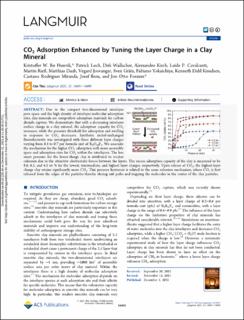| dc.contributor.author | Hunvik, Kristoffer William Bø | |
| dc.contributor.author | Loch, Patrick | |
| dc.contributor.author | Wallacher, Dirk | |
| dc.contributor.author | Kirch, Alexsandro | |
| dc.contributor.author | Cavalcanti, Leide Passos | |
| dc.contributor.author | Rieß, Martin | |
| dc.contributor.author | Daab, Matthias | |
| dc.contributor.author | Josvanger, Vegard | |
| dc.contributor.author | Grätz, Sven | |
| dc.contributor.author | Yokaichiya, Fabiano | |
| dc.contributor.author | Knudsen, Kenneth Dahl | |
| dc.contributor.author | Miranda, Caetano Rodrigues | |
| dc.contributor.author | Breu, Josef | |
| dc.contributor.author | Fossum, Jon Otto | |
| dc.date.accessioned | 2022-03-04T13:03:06Z | |
| dc.date.available | 2022-03-04T13:03:06Z | |
| dc.date.created | 2021-12-21T12:53:21Z | |
| dc.date.issued | 2021 | |
| dc.identifier.citation | Langmuir. 2021, 37 (50), 14491-14499. | en_US |
| dc.identifier.issn | 0743-7463 | |
| dc.identifier.uri | https://hdl.handle.net/11250/2983194 | |
| dc.description.abstract | Due to the compact two-dimensional interlayer pore space and the high density of interlayer molecular adsorption sites, clay minerals are competitive adsorption materials for carbon dioxide capture. We demonstrate that with a decreasing interlayer surface charge in a clay mineral, the adsorption capacity for CO2 increases, while the pressure threshold for adsorption and swelling in response to CO2 decreases. Synthetic nickel-exchanged fluorohectorite was investigated with three different layer charges varying from 0.3 to 0.7 per formula unit of Si4O10F2. We associate the mechanism for the higher CO2 adsorption with more accessible space and adsorption sites for CO2 within the interlayers. The low onset pressure for the lower-charge clay is attributed to weaker cohesion due to the attractive electrostatic forces between the layers. The excess adsorption capacity of the clay is measured to be 8.6, 6.5, and 4.5 wt % for the lowest, intermediate, and highest layer charges, respectively. Upon release of CO2, the highest-layer charge clay retains significantly more CO2. This pressure hysteresis is related to the same cohesion mechanism, where CO2 is first released from the edges of the particles thereby closing exit paths and trapping the molecules in the center of the clay particles. | en_US |
| dc.language.iso | eng | en_US |
| dc.publisher | American Chemical Society | en_US |
| dc.rights | Navngivelse 4.0 Internasjonal | * |
| dc.rights.uri | http://creativecommons.org/licenses/by/4.0/deed.no | * |
| dc.title | CO2 Adsorption Enhanced by Tuning the Layer Charge in a Clay Mineral | en_US |
| dc.type | Peer reviewed | en_US |
| dc.type | Journal article | en_US |
| dc.description.version | publishedVersion | en_US |
| dc.source.pagenumber | 14491-14499 | en_US |
| dc.source.volume | 37 | en_US |
| dc.source.journal | Langmuir | en_US |
| dc.source.issue | 50 | en_US |
| dc.identifier.doi | 10.1021/acs.langmuir.1c02467 | |
| dc.identifier.cristin | 1971033 | |
| dc.relation.project | Norges forskningsråd: 25072 | en_US |
| cristin.ispublished | true | |
| cristin.fulltext | original | |
| cristin.qualitycode | 2 | |

